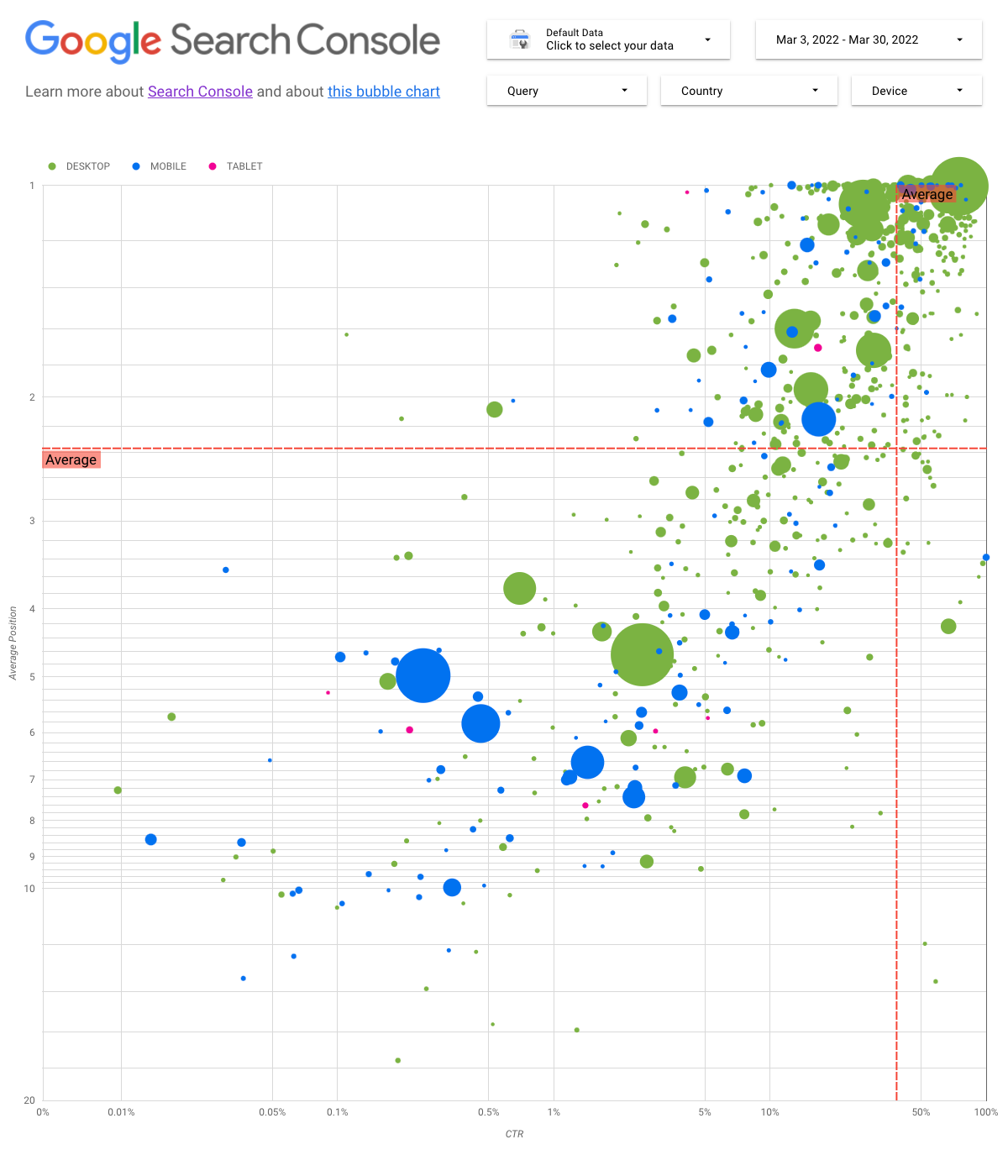2021 年 4 月 6 日(星期三)
分析网站在 Google 搜索中的表现数据始终是一项挑战,存在可视化和理解难度更大的大量长尾查询时,情况更是如此。在这篇博文中,我们会为您提供一些提示,帮助您发掘优化网站在 Google 搜索中表现的机会。
如果您还没有阅读我们关于将 Search Console 关联至数据洞察以及使用数据洞察实现 Google 搜索流量监控的近期博文,不妨先看一看这些内容,详细了解在数据洞察中使用 Search Console 可实现哪些功能。
今天,我们将讨论气泡图,它可以帮助您了解进行哪些查询时网站表现良好,进行哪些查询时网站的表现有待改进。首先,我们将说明该图表中的主要元素,说明各类具体设置及其对数据的影响。然后,我们将提供一些指引,说明您在分析数据时需要注意的事项。
首先是好的方面,您无需从头开始构建图表,只要使用此模板关联到您的数据,并调整您想要的各种设置即可。
废话少说,直接看图…

解读图表
存在多个指标和维度时,气泡图是一种较直观的可视化图表,因为它可以让您更高效地发现数据中的关系和模式。在本例中,您可以同时查看不同维度(查询、设备)的各种流量属性(点击率、平均排名)和数量(总点击次数)。
我们将通过一些图表元素来说明图中展示的内容,以及未展示的内容。
数据源
在该图表中,我们使用的是通过 Search Console 数据源获取的网站展示次数表格,其中包括按网站和查询汇总的 Google 搜索表现数据。
过滤条件和数据控制
为了便于您有效地控制您的数据,我们在图表中提供了 5 个自定义选项:
- 数据控制:选择要分析的 Search Console 资源。
- 日期范围:选择您要在报告中查看的日期范围;默认情况下,您会看到过去 28 天的数据。
- 查询:包含或排除要重点关注的查询。您可以使用正则表达式,方法与在 Search Console 中使用它们时类似。
- 国家/地区:包含或排除国家/地区。
- 设备:包含或排除设备类别。
坐标轴
图表中的坐标轴是平均排名(y 轴)和网站点击率(x 轴),但为使图表展示出更深入的分析数据,我们进行了 3 项重要转换:
- 逆转 y 轴方向:由于 y 轴显示平均排名,逆转该轴是指 1 位于顶部。 对于大多数商务图表而言,最佳排名是右上角,因此使用 y 轴显示平均排名时,逆转其方向会显得更直观。
- 对数刻度:对数刻度是指“以紧凑的方式显示较大范围的数值数据,沿刻度移动一个距离单位表示数字乘以 10”。对这两条轴使用对数刻度,您可以更好地了解图表中几种极端查询(点击率非常低、平均排名非常低或两者都非常低)的情况。
- 参考行:参考行非常有助于突出显示高于或低于特定阈值的值。查看平均值、中位数或特定百分位数可以让您注意到偏离特定模式的情况。
气泡
图表中的每个气泡都表示单个查询,为了使图表更有用,我们使用了两个样式属性:
- 大小:用气泡大小代表点击次数,有助于您一目了然地看出哪些查询带来了大部分流量:气泡越大,查询产生的流量越多。
- 颜色:用气泡颜色代表不同设备类别,有助于您了解网站在移动设备上与桌面设备上的 Google 搜索表现的差异。您可以使用颜色区分各维度,但随着值数量的增加,识别模式的难度会随之增大。
分析数据
这种可视化方式的目标是帮助发现查询优化机会。该图表显示了查询相关表现,其中 y 轴表示平均排名,x 轴表示点击率,气泡大小表示总点击次数,气泡颜色表示设备类别
红色参考线显示了每条轴的平均值,将图表拆分为象限,以显示四种类型的查询表现。您的象限划分情况可能与这篇博文中显示的结果有所不同;具体取决于您的网站查询的分布方式。

一般来说,该图表会显示四个类别,您可以对其进行分析,以确定优化查询表现时要在哪些方面投入时间。
- 高排名,高点击率:您无需针对这些查询采取任何行动;现在的效果很理想。
- 低排名,高点击率:此类查询似乎与用户相关;即使这些查询的排名低于您网站的平均查询排名,也会获得较高的点击率。如果这些查询的排名提高,可能会带来巨大的贡献,请花时间优化这些查询!
- 低排名,低点击率:查看点击率较低的查询(本类别以及下一条的类别)时,请特别注意查看气泡大小,了解哪些查询点击率较低但仍然带来了大量流量。虽然此象限中的查询看似不值得您投入时间进行优化,但它们可以分为两大类:
- 相关查询:如果这些查询对您来说非常重要,那么这是个很好的开始,因为这表示这些查询已经显示在 Google 搜索中。 请优先优化这些查询而非完全不会出现在搜索结果中的查询,因为这类查询更容易优化。
- 不相关查询:如果查询与您的网站无关,建议您调整内容,使其侧重能带来相关流量的查询。
- 高排名,低点击率:这些查询可能会因各种原因而点击率较低。您应该查看最大的气泡,以发现是否存在以下情况:
- 您的竞争对手可能使用了结构化数据标记,且展示的是富媒体搜索结果,可能会吸引用户点击竞争对手的结果而非您的结果。不妨为您的网站启用搜索结果功能。
- 您可能优化了与您的网站有关但用户并不感兴趣的查询,或偶然获得了此类查询的高排名。
- 用户可能已经找到所需的信息,如贵公司的营业时间、地址或电话号码。
优化网站的表现
当您找到值得投入时间和精力优化的查询后,请务必参考搜索引擎优化 (SEO) 新手指南针对这些查询进行优化。以下是一些建议:
- 确保
title元素、说明meta标记以及alt属性具有描述性、具体且准确。 - 使用标题元素强调重要文字,为您的内容创建层次结构,便于用户和搜索引擎浏览文档。
- 添加结构化数据标记向搜索引擎说明您的内容,以便在搜索结果中以有用的(且吸引用户的)方式显示您的内容。
- 思考用户找到您的某些内容时可能用到的搜索字词。您可以借助 Google Ads 提供的关键字规划师来发现新关键字变体,并了解每个关键字的大概搜索量。您还可以使用 Google 趋势,从与您的网站相关的热门主题和查询中寻找优化灵感。
反馈
与往常一样,如果您遇到任何问题,请通过 Google 搜索中心社区或数据洞察社区告知我们。此外,如果您使用 Twitter,请务必关注我们;我们会在未来推送更多相关博文。
